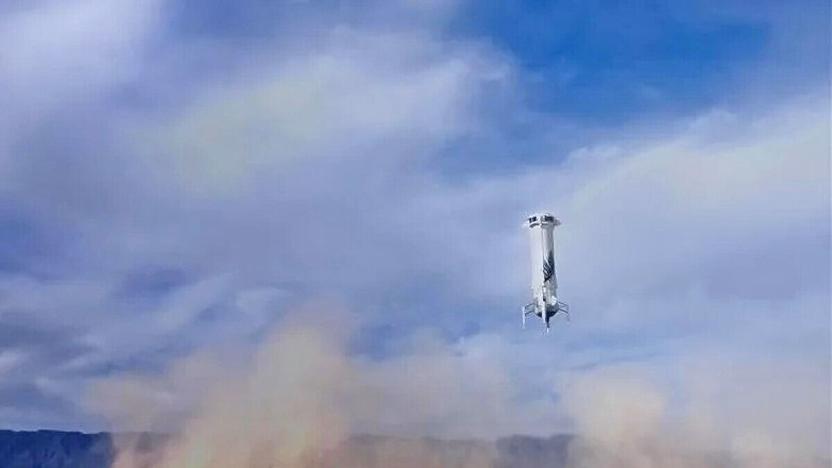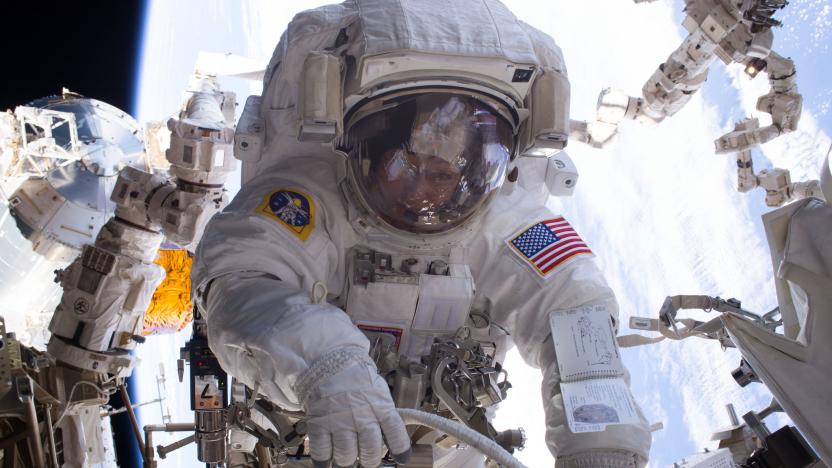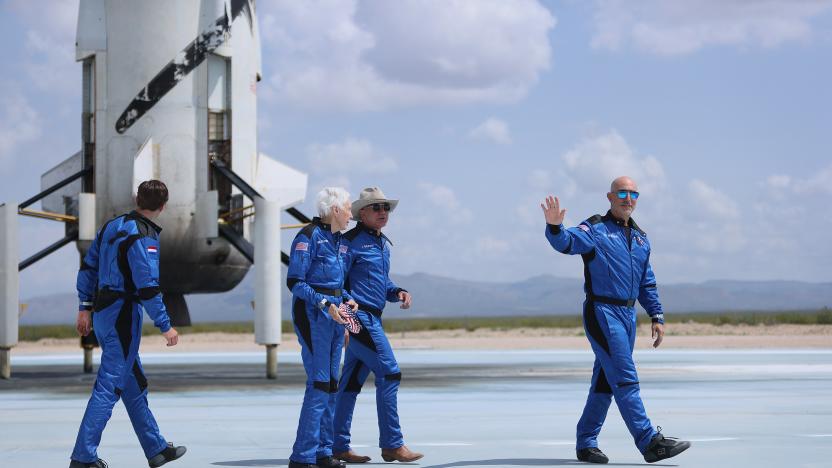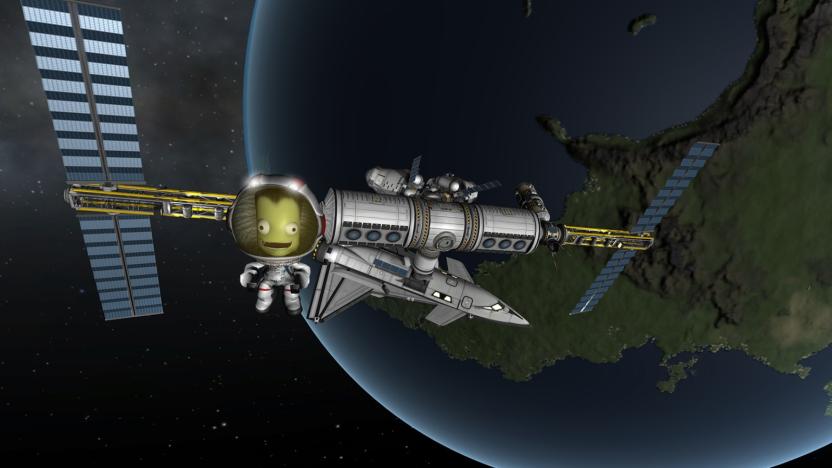space travel
Latest

Blue Origin successfully launches New Shepard rocket after failed 2022 attempt
Blue Origin’s 24th mission is officially a success. The New Shepard rocket took off as planned this morning and the booster and crew capsule safely separated mid-flight and landed back on this great blue marble we call Earth.

Anemia could make space travel to Mars a challenge, study finds
Anemia is more serious than thought in space and may create challenges with future travel to Mars.

The FAA will give Bezos and Branson its last astronaut wings
The Federal Aviation Administration is abruptly ending its award for commercial spaceflight, and its final recipients are exactly the people who can afford to go to space for fun.

Lettuce grown on the ISS is as nutritious as Earth harvests, scientists find
The red romaine lettuce astronauts grew on the ISS a few years ago aren't just as good as Earth-grown lettuce, they're also as nutritious. NASA's Gioia Massa, Christina Khodadad and their colleagues examined and analyzed three batches of lettuce grown on the space station between 2014 and 2016. They compared it to lettuce that they grew here at home under similar conditions -- in the same relative humidity, carbon dioxide concentration and temperature, among other things -- and determined that the level of nutrients between them is very similar.

HBO’s ‘Avenue 5’ asks what happens if tech bros conquer space
If you thought that HBO was done mocking technology companies now that Silicon Valley is done, think again. Avenue 5 is the channel's new sitcom, and one that asks the question: "What if tech bros were in charge of more than just our internet histories?'" The answer, at least according to the first half of the season, is that it won't be pretty -- or safe.

‘Kerbal Space Program’ gets an interstellar flight sequel
It's been four years since Kerbal Space Program (KSP) -- the spacecraft building and flight simulation game -- officially launched. While Elon Musk once called the title "awesome" and joked that SpaceX used KSP for testing software, it was due for a refresh. Today, Private Division announced that Kerbal Space Program 2 (KSP2) will arrive in 2020. As part of the reveal, it released cinematic trailer and a (dramatic) developer story.

ICYMI: The DroneGun aims to patrol the skies
try{document.getElementById("aol-cms-player-1").style.display="none";}catch(e){}Today on In Case You Missed It: DroneShield has been touring airports across the country to test out its DroneGun, a rifle-sized UAV jammer that disables a drones' GPS and GLONASS positioning from over a mile away. While it hasn't received FCC certification yet, the DroneGun aims to force UAVs to land -- unharmed -- and could possibly lead authorities to the pilot and launch point, which could prove to be helpful in removing drones from air space or protecting soldiers against drone bombs.

ICYMI: Tech for rhinos, smarter spacecraft design and more
#fivemin-widget-blogsmith-image-814839{display:none;} .cke_show_borders #fivemin-widget-blogsmith-image-814839, #postcontentcontainer #fivemin-widget-blogsmith-image-814839{width:570px;display:block;} try{document.getElementById("fivemin-widget-blogsmith-image-814839").style.display="none";}catch(e){}Today on In Case You Missed It: Small cameras are being implanted in endangered rhino's horns to save them from extinction. An aerospace company designed a new engine which could power a spacecraft via Earth-based microwave emitters. And theme-park goers who love 4D immersive-motion rides may soon be able to put similar tech on their living room sofa.

SpaceX's new rocket facility officially lands in Brownsville, Texas
SpaceX made clear that it was going to put a launch facility in Texas before long, and today we've received the full skinny on just where that base is going. As suspected, the Governor's Office has announced that the commercial spaceport will be built in Brownsville, near the Mexico border. The state says it will pump a total of $15.3 million into the region to help create the necessary infrastructure. This isn't SpaceX's first Texan location (it already has a development site in McGregor), but it will certainly be the most conspicuous -- especially if rumors of multiple vehicle launches per day ultimately prove true.

China launches Jade Rabbit rover, kicks off Chang'e 3 moon mission
China began stage one of its Chang'e 3 mission yesterday afternoon by launching a Long March 3B rocket toward the troposphere, destined for the moon. The Jade Rabbit, a robotic rover, managed to hop along for the ride with intentions of roaming our rocky satellite's surfaces. Lunar touchdown is scheduled for December 14th, which marks the first time a craft will settle down on the ole' ball of cheese since the Soviet's Luna 24 mission in 1976. Between Virgin Galactic and the Google-backed Lunar X Prize competition, traveling throughout the universe may finally be less of a science fiction fantasy and more of an everyday reality -- one that China isn't ignoring. According to the deputy engineer-in-chief in charge of the second phase of China's lunar program, Sun Huixian, "China's space exploration will not stop at the moon... Our target is deep space."

Voyager 1 reaches 'magnetic highway,' gets a taste of interstellar space
We're trying, with all our might, to avoid mention of final frontiers. Really we are. But, NASA's Voyager 1 is at the last point before crossing one. Currently the spacecraft is passing through what scientists are calling a "magnetic highway." This region is where the sun's magnetic field lines connect out to interstellar ones, which allows charged particles from our heliosphere (a surrounding cloud of charged particles encasing the sun) to pass out, while higher-energy particles from outside stream in. This area is still considered inside our solar bubble -- due to the lack of change in the direction of magnetic field lines -- but thanks to the ingress of external particles, it does give NASA a taste of conditions in deeper areas of the galaxy. Likewise, the agency believes this is the final... stage before reaching interstellar space, which it's estimated Voyager 1 will encounter in anything from a few months, to a couple of years' time.

NASA and IHMC building X1 exoskeleton to give us a lift, keep us fit in space and on Earth
It's hard to deny the appeal of a space-bound robot like NASA's Robonaut 2, fears of subversion notwithstanding. The space agency and Florida's Institute for Human and Machine Cognition know it, and they want to put that technology into an exoskeleton with a nobler purpose than performing chores on space stations. The in-development X1 (not yet pictured) adapts the Robonaut's skills to a body-hugging frame with 10 points of movement that might give humans an assist when they need it the most. In space, the X1 could automate and add challenge to exercise for astronauts in low gravity, or provide the extra muscle for that fabled day we return to manned surface exploration. NASA envisions its exoskeleton having more grounded uses as well, such as rehabilitation for leg injuries or walking for those who never had the chance. Although we're not expecting a rapid turnaround knowing NASA's lengthy schedules, we might see the X1 in use sooner than most such products in the wake of a purposefully quick development cycle -- and, no doubt, a few interested customers here on Earth.

US and Russian space agencies to launch first year-long mission on the ISS
If you thought that year out around Europe was an eye opener, how about 12 months on the International Space Station? That's what's in store for two unnamed astronauts. Currently, the maximum stay on the ISS is six months, but in 2015, one Russian, and one American will work their way through the whole calendar, in a trip that could help pave the way for deep space travel. Plenty of data has already been collected about the effect microgravity has on the body, but less is known of the longer-term implications. NASA is already considering sending manned expeditions to near-Earth asteroids and Mars in the coming decades -- but the results from this excursion could prove invaluable. The names of the chosen two haven't been revealed, and the Soyuz capsule's (currently unaccounted for) third-seat has also sparked talk of another person possibly coming along for the ride. Time to re-plan that gap year?

Space Shuttle Atlantis hands-on: a look inside (video)
Space Shuttles Discovery, Endeavour and Enterprise have all left Kennedy Space Center for new homes, but Atlantis? She's staying. Come November 2nd, the orbiter will be wheeled out to a 65,000-square-foot exhibit, which is still being constructed at KSC's visitor complex. Though the craft's cargo bay doors will be open and its remote manipulator arm extended when its displayed, visitors won't be able to climb aboard it -- or any of the other shuttles, for that matter. However, we got the chance to visit Bay 2 of the Orbiter Processing Facility, step inside Atlantis and give it the hands-on treatment. Look out below for the gallery or hit the jump for the full video tour.

NASA's Curiosity rover checks in on Foursquare, gives Mars its first mayor
Yes, seriously. NASA announced on Wednesday that its Curiosity rover had "checked in" on Mars via Foursquare. Marking the first check in from another world, the robotic rover will utilize the location-minded social network to share updates and pictures while visiting the Red Planet. While Curiosity will continue to explore the possibilities of Mars being able to sustain life, it would appear that the fourth planet from the sun just got a brand new mayor. Something tells us the universe's rarest badge is about to be bestowed.

SpaceX to start International Space Station cargo runs on October 7th, kick off routine private spaceflight
SpaceX just put a date on when private space travel becomes a seemingly everyday affair: October 7th. That's when the company and NASA expect to launch a Falcon 9 rocket from Cape Canaveral Air Force Station delivering the first of a dozen cargo loads to the International Space Station through the unmanned Dragon spacecraft. While we're not expecting any trouble -- SpaceX has done this before -- there's a chance for a rescheduled launch on October 8th if there are any minor setbacks. The flights won't achieve the cachet of government-funded runs with human beings onboard, but we're sure the company doesn't mind when it's taking steps towards democratizing spaceflight... and pocketing $1.6 billion in the process.

Curiosity rover starts light robotic arm workout in preparation for scientific main event
As NASA promised, Curiosity has stopped at the quarter pole toward its first scientific destination to test its robotic arm and attached scientific instruments. After 100 yards of driving, the rover extended its 7-foot limb, and will now spend six to ten days checking its predetermined positions and range of motion. That will ensure the appendage is ready after surviving the chilly vaccuum of space and subsequent setdown, and will let its minders see how it functions in the unfamiliar Martian gravity and temperatures. The JPL scientists in charge of the six-wheeler will also peep the Mars Hand Lens Imager and made-in-Canada Alpha Particle X-Ray Spectrometer to warrant that they're up for all the geology to come. If all goes well, the rover will start scooping, drilling and analyzing in earnest when it hits Glenelg, then Mount Sharp -- so, we'd limber up first before tackling all that, too.

Mars Curiosity leaves its landing area, heads to distant frontier a quarter-mile away
Now that Curiosity has survived its thrill-a-minute landing and passed an upgrade and physical with (nearly) flying colors, the rover is off to earn its $2 billion keep. The trip started well, with the buggy driving 52 feet towards its first science site "beautifully, just as our rover planners designed it," according to NASA. The destination, Glenelg, is 1,500 feet away from the now-familiar Bradbury Landing where it first set down, which is pretty far for a rover that treks along at about a tenth of a mile per hour. On top of that, its minders have some stops in mind to test instruments -- meaning it'll arrive there in about two weeks. Once at Glenelg, Curiosity will scope the unusual geology of the region, though its principal destination for science is Mount Sharp, a relatively vast six miles away. Don't worry about it running out of gas, though -- the nuclear power supply will last a full Martian year, or 687 earth days.

Liftport turns to Kickstarter for space elevator experiment (video)
Space elevators are slowly making the transition from science fiction to science fact... but we're not quite there yet. LiftPort, a group that already holds the record for tallest elevator, is taking a second stab at the technology after going into "hibernation" in 2007. Founder Michael Laine has resurrected the company and taken to Kickstarter to drum up interest (as well as a little cash) in his latest project -- a lunar elevator. As Laine explains in the video, an elevator from the surface of the Moon to a rendezvous point between the Earth and its satellite is actually possible using current technology. And, thanks to its low gravity and lack of atmosphere, a much simpler construction site. The first step is a $1 million feasibility study that will involve a two kilometer tall elevator here on Earth. LiftPort has already far exceeded its Kickstarter goal of $8,000, but the point was never to fund the entire project. The hope was to garner some media attention and get people involved and invested (both financially and emotionally) by offering rewards. You could even pledge enough money to base jump from the top of the tethered research tower, which will be held aloft by helium balloons. For more info check out the video after the break and hit up the source link to pledge your hard earned cash.

Voice signals sent to Mars and back, while telephoto images tease rich geology
The Martian hills are alive with the sound of music. Well, NASA Administrator Charles Bolden's voice at least, as the agency reveals that the first recorded human voice has traveled from Earth, to another planet, and back. The words might not have literally echoed in the surrounding hills, but by having been beamed to Curiosity and back again, have made a small step towards interplanetary communication. Along with the motivational words of Bolden, the rover returned some telephoto images from the onboard 100mm and 34mm lenses. The pictures show the hills toward which Curiosity is bound, and tease the scientists with their rich-looking -- and hopefully revealing -- layers of geology. Want to know what interplanetary voicemail sounds like? No need to go to Mars and back, just click on the more coverage link below.












